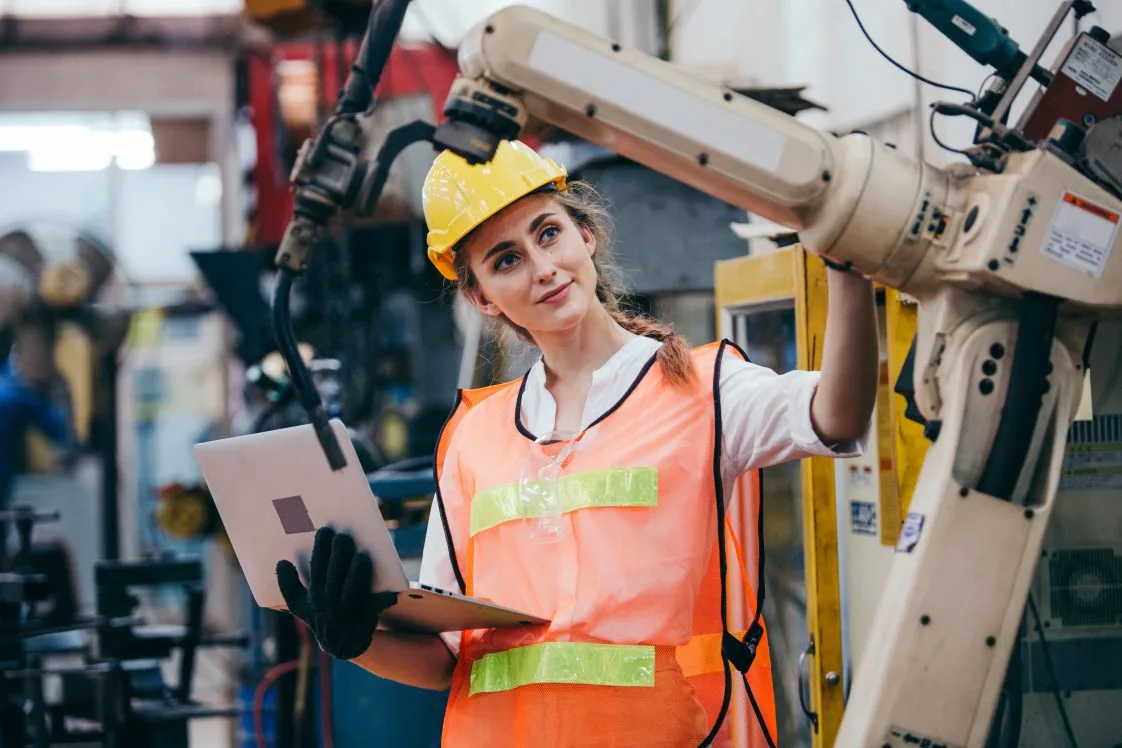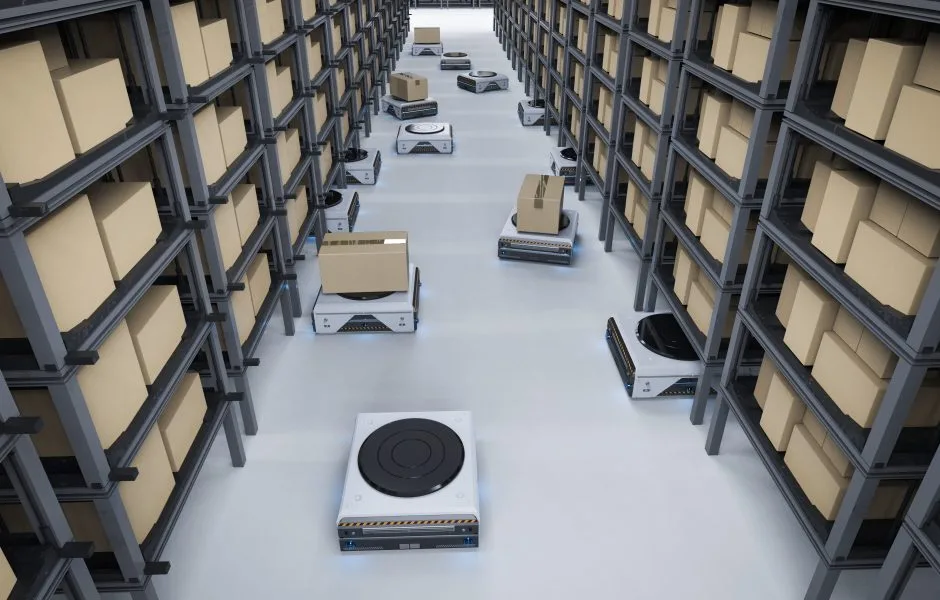Retail Robotics: What to Know Before Implementing Robotic Order Fulfillment
In this ebook, explore the challenges retailers are facing in order fulfillment today, the role robotics can and can’t play, and whether implementing robotic order fulfillment is right for your business — and customer experience.
Robotics is transforming retail through automating processes that enable retailers to speed up DTC fulfillment, improve accuracy, decrease fulfillment labor costs, and scale at rates previously unattainable. The advancement of IoT and machine learning has facilitated breakthroughs in retail robotics that promise to revolutionize order fulfillment — eventually.
While some retailers are opening robotic-only fulfillment centers, many retailers are just on the verge of evaluating if, where, when, and how to implement robotics. How do you determine the best robotics strategy for your eCommerce retail business?
In this ebook, explore the challenges retailers are facing in order fulfillment today, the role robotics can and can’t play, and whether implementing robotic order fulfillment is right for your business — and customer experience.

Order Fulfillment Remains Challenging
There has never been a time when order fulfillment was easy. But as customer expectations have advanced, it’s only become more difficult — and requires more orchestration — than before. Customers expect:
- Fulfillment coupled with broad shipping options
- Real-time visibility into fulfillment and delivery status
- Real-time communication and notifications throughout the process
- Easy, hassle-free returns
- Frictionless customer care
Today’s customers are more aware of the supply chain and order fulfillment than in the past; and with multiple order fulfillment options available (like store fulfillment’s BOPIS, BOPAC, ship to store, etc.), they believe that every retailer should be able to deliver to the highest standards.
Technology has helped drive expectations; often faster than many retailers can realistically meet. Retailers face significant challenges:
- Speed. Customers expect fast delivery, typically within three days. However, moving this fast requires a seamless, integrated ecosystem of technology, inventory, suppliers, fulfillment, logistics, and carriers — all working together to meet the same timelines and goals. This orchestration often requires industry heft and resources; and it can leave smaller retailers grappling to figure out how to keep pace.
- Volume. Omnichannel shopping has become a way of life; and customers now see their shopping experiences channel agnostic, i.e., they buy from brands and it no longer matters if they buy online or instore, they move fluidly among both as one holistic shopping experience. eCommerce orders are only increasing with mobile shopping and social commerce — which means retailers face a growing order volume year round, not just during peak surges.
- Supply chain. Pandemic-induced supply chain woes are easing, but most retailers learned the hard way that it is imperative to have multiple suppliers available for products. They also discovered the need for supply chain visibility and integrated systems that enable them to track potential issues before it impacts the customer.
- Scalability. Speed and volume drive the need for true scalability — which is the ability to scale up or down automatically without having to wait to add hires or expand to more facilities.
- Forecasting. Since the pandemic, forecasting has become exceedingly difficult with sudden disruption, unexpected surges in product demands, and competitors driving discounts and sales outside of non-traditional timeframes. Retailers struggle to accurately forecast and be able to scale staffing and fulfillment processing.
- Legacy technology. Many retailers have a blend of old legacy technology and newer cloud-based platforms, which require integration to connect with each other. It’s common for retailers to use multiple, disconnected systems that make it exceedingly difficult to streamline processes, automate, and keep everything in sync. Robotics requires modern technology.
- Labor. Finding labor for order fulfillment remains challenging and a lengthy process of recruitment, hiring, onboarding, training, and ramp up. Turnover makes knowledge transfer and scalability difficult.
- Cost of real estate, operations, hiring, training. For larger mid-market and enterprises, there is the growing cost and lack of available real estate for fulfillment centers, the rising costs of operations, and the costs of hiring and training employees.

It’s true that many of these are traditional fulfillment challenges — the difference is that everything is moving at a greater velocity and customer expectations only continue to rise. Retailers that fail to deliver a great customer order fulfillment experience end up losing customers to competitors that can do so and lose brand loyalty. Customers have little tolerance for a poor experience; and a plethora of options for buying products from other sellers. Order fulfillment is crucial — if only secondary to the browsing and shopping experience itself — in delivering a positive customer experience.
Which leads retailers to wonder if robotics is the best way to improve order fulfillment.
What Robotics Is And What It Isn’t
Robotics is a form of automation; and much like manufacturers at the beginning of the Industrial Revolution in the early 1900s, today’s retailers are poised to let machines take over work currently performed by humans. Or, in some cases, assist humans in order fulfillment. The intention? Machines can work more accurately, tirelessly, faster, and with greater efficiency than humans. Machines promise to free humans from rote, repetitive work, as they have historically done so.
Retail robotics is another path toward meeting customer expectations. But while it offers much, it’s not a magical cure for disordered or disconnected order fulfillment operations. Like any machine, it is only as good as its programming and the people that deploy it.
So, what is robotics in the retail industry?
- Automated performance. Robots provide automated performance according to their programming and their technological capabilities. They perform work as they are instructed and, as long as there are no glitches, they repeat their performance without error, variance in timing, or other variables that humans bring to the workforce. This enables fulfillment centers to accurately calculate the volume of work robots can perform in a set amount of time, and predict performance and scale with significant accuracy.
- An artificial workforce made of IoT machines. There is much discussion and concern that robots will replace human workforces, especially as artificial intelligence advances. As in the Industrial Age, IoT machines do replace human jobs. This is a true, but difficult fact. Retailers looking to implement robotics will be replacing a significant part (if not all) of their fulfillment center workforce with an artificial workforce. Displaced workers in this industry will likely need to retrain and migrate to other fields.
- Scalable and fast. Robots are capable of working faster, with less error, and at greater scale than humans are. And, for many robotic fulfillment centers, scaling becomes a matter of adding more machines, which only require programming before being capable of peak performance. Robotic fulfillment centers do require real estate, and when a center reaches its max robotic capacity, retailers will need to acquire or build new facilities to scale.
- Sophisticated technology. Retail robotics are built with AI IoT machines, which means they use advanced technology to connect, communicate, and perform their duties. Deploying robotics requires retailers to have cloud-based systems and platforms that integrate with their order management platform, inventory management platform, and other key systems.
There are some misconceptions that robotics are the be-all-and-end-all of order fulfillment solutions. This is untrue. Robots are not:
- Infallible. Robots are machines made and programmed by humans. As such, they are not perfect and they can and do make errors. Quality assurance needs to remain high in robotic fulfillment centers.
- Replacement for human decision-making. As much as robots can replace pick-and-pack and other fulfillment tasks, they are not capable of making decisions outside the scope of their programming. Even ChatGPT-enabled robots will still need to be supervised and managed — which means humans need to remain in managerial roles in fulfillment centers.
- Infinitely scalable. While robots can easily be scaled up or down based on volume, and provide a higher velocity of work than human laborers, they cannot scale infinitely. As mentioned earlier, there will come a point where retailers will need to expand real estate to accommodate growth and scale further.
- Capable of being added without modernizing the tech stack. It is a misconception to assume that robots can be added without investing in fully modernizing the retail tech stack. Unlike humans that can deal with multi-context complexity, make decisions in the moment, adapt to disruption, change the way they work to meet different needs, and understand when to prioritize different tasks — robots do what they are programmed to do, according to the rules they are given. Their success depends on being connected to data that is flowing in from multiple platforms and being monitored by human supervisors.
- Magical answer to otherwise disordered chaos. Fulfillment centers that have poorly designed operations, that are in a tangled mess of legacy on-premises technology and modern cloud technology, that have disconnected systems from the supply chain ecosystem, and that simply are operating in disordered chaos, cannot expect robotics to work miracles. It’s true that a robotic system can and will create order and operate methodically, but without everything else in the fulfillment center supporting that organization and structured workflow, problems will continue.
There are many things robots can and can’t do for retail order fulfillment. Overall, bringing in or switching to robotic fulfillment will help retailers meet customer expectations. It may be a question of when, where, what, and to what degree to implement them.
Is robotic order fulfillment right for you?
As you can see, there are many things to consider before implementing robotics. As in every aspect of retail, the number one driving force should be its ultimate impact on customer experience.
Here are some questions to consider:
- How will robotic fulfillment impact our customer experience (CX)? Do not just assume it will be positive. Carefully ponder what it will change across the CX journey.
- How will it affect our employee experience and our vendors, suppliers, carriers?
- Do we have a modern tech stack capable of supporting an AI and IoT robotic workforce? If not, what needs to be done before we’ll be ready? Talk to IT about this to get a feel for the investment, timeline, and implications.
- Are we ready for the cultural change it will entail? Replacing humans with robots will mean layoffs, reskilling, and reorganizing.
- Do we have sufficient skillsets in place to manage a robotic workforce? If not, where will we source them from?
- What will be our business continuity plan for a robotic order fulfillment operation should we lose internet, electricity, or climate control?
- Do we have the resources, time, and skillsets needed to own and operate our own robotic fulfillment center or would we be better served by outsourcing it?
That last question should be addressed after initial exploratory research. Keep in mind that third-party logistics that offer robotic fulfillment centers, like Radial, are happy to walk you through the pros and cons of owning vs outsourcing this solution.
Once you’ve determined that implementing robotics is right for you, a decision needs to be made about whether to own or outsource it.
Building and owning your own robotic fulfillment center may be right for you, if:
- You already own major fulfillment centers and have the real estate and core operations in place to supplement or switch to robotic fulfillment.
- You have an advanced IT team ready to deal with AI and IoT robotics.
- Your HR department is ready to manage a hybrid machine and human workforce.
- You will experience more cost savings by altering or shutting down traditional fulfillment and buying and deploying robotic solutions.
Outsourcing robotic fulfillment may be right for you, if:
- You would rather outsource fulfillment to someone who will share or offload some of the financial risk in owning and developing fulfillment centers, operations, and robotics.
- You do not have the IT expertise to manage AI and IoT robotics.
- Your HR team has no experience in managing a hybrid workforce and you are concerned with the liability of displaced workers.
- You don’t want to invest the time in dismantling current systems and practices to implement new robotic ones.
Additionally, robotics is still in its early days. It is fair to say that many retailers would rather let someone else shoulder the initial risk and test the waters, before committing to a complete robotic operation.
How Radial Uses Robotic Order Fulfillment
Radial embraces robotic order fulfillment systems across our fulfillment centers as part of our commitment to innovation and operational excellence.
By leveraging robotics, Radial streamlines and enhances the order fulfillment process. Our vision revolves around harnessing cutting-edge technology to deliver intelligent and efficient fulfillment solutions that meet the evolving demands of the market, deliver orders efficiently, and provide customers with exceptional service.
See how we’re deploying Covariant robotics.

